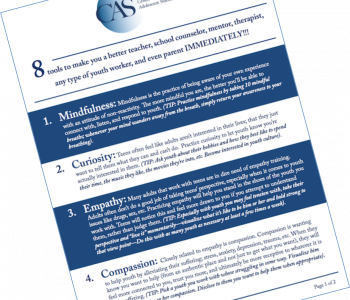

Catharine Hannay, MA
Catharine Hannay is the founder of MindfulTeachers.org and the author of Being You: A Girl’s Guide to Mindfulness, a workbook for teen girls on mindfulness, compassion, and self-acceptance.
6 Tips for Helping Teens Deal with Back-to-School Stress and Anxiety
This year, in addition to the usual back-to-school jitters, teens are getting hit from all sides during the pandemic:
- They may be hearing alarming misinformation about COVID, or have legitimate concerns about a highly contagious illness;
- They may be pawns in the competing agendas of parents, teachers, school administrators and government leaders about mask-wearing, vaccinations, and in-person vs. online learning;
- They may have been sick themselves, or had friends or family members become quite ill or die from COVID;
- Their family may have lost significant income during lockdown, and/or there may have been a lot of tensions with multiple adults and kids sharing a small space and trying to keep up with their work and studies;
- They’re likely grieving the loss of important rites of passage they missed the last couple of years (the prom, graduation ceremonies, sports and activities); and
- They may be nervous about heading back into the classroom, especially if they have social anxiety or fears of bullying. (See ‘Some kids don’t want to return to in-person schooling’)
Frankly, I’d be surprised if any teens aren’t experiencing anxiety these days. While there’s a lot we can’t control, there are a few ways adults can help kids as they transition into another uncertain and stressful new school year.
Tip #1: Start with a Quick Check-in
A quick check-in is a good way to get an overall sense of the mood of the group, and can also help you identify which youth might be in need of additional support.
Dr. Sam Himelstein describes several different ways to do this, including:
- The Mindful Check-in: “Basically, this involves the teen first taking a breath and collecting their thoughts prior to actually speaking. […] They might share an emotion (e.g., happy, sad), a physical feeling (e.g., I’m really tired right now), or even a mental experience (e.g., overwhelmed with thoughts). […] I encourage youth to avoid general adjectives like “cool” “fine” “good” “okay” “alright” because they’re used so much in everyday conversation […] that they lose meaning and don’t necessarily describe how someone is actually feeling.”
- Internal Weather Report: “Tell the youth that their feelings are like the weather. They can feel like there’s a sunny day inside (e.g., happy, joy), like it’s gloomy and grey (e.g., bored, down), rainy (e.g., sad, depressed), stormy (e.g., irritated, angry, etc.), or anything else they can think of. […] Let them define the weather and its connected emotions however they want.”
For more suggestions, see ‘6 Ways to Check in with Teens’
Tip #2: Don’t Confuse Support and Advice
How often have we all been on one side or the other of this conversation?
“I feel ____________.”
“You should ____________.”
Like any of us, sometimes teens just need to blow off steam. If they mention that they’re anxious or stressed, they may not be looking for advice. They may just need someone to listen to them and express support.
“I feel anxious (or stressed or pissed off, etc.).”
“Wow. That sounds really tough (or frustrating or annoying, etc.).”
After this, if you do have suggestions, they’ll be much more likely to follow your advice because they’ll feel like you care about them and understand their challenges.
Tip #3: Manage Your Own Stress and Anxiety
I remember the hardest part of being a teen was when my mom overreacted to my overreactions! A calm, stable adult presence can make an enormous difference when it feels like everything else in their world is spinning out of control.
It isn’t realistic to expect youth to remain calm when they’re surrounded by adults who are losing it. And any advice you might give will seem inauthentic if you’re clearly not managing your own anxiety.
There are a lot of different acronyms for taking a mindful pause to calm down and clear your head. Here at CAS, we like Dr. Sam Himelstein’s acronym T.A.P.
TAP stands for:
- Take a breath. Pause even for just a couple of seconds before (over)reacting.
- Acknowledge your internal experience, as well as what might be going on for the youth.
- Proceed with whatever action or discussion seems most skillful in the moment.
You can see more about TAP in the following posts:
- 4 Ways to Improve Difficult Relationships with Youth
- 3 Ways Compassion Can Help Youth Impacted by Trauma
Tip #4: Practice Authenticity and Skillful Self-Disclosure
“We could each of us name persons whom we know who always seem to be operating from behind a front, who are playing a role, who tend to say things they do not feel. […] We do not reveal ourselves too deeply to such people. On the other hand each of us knows individuals whom we somehow trust, because we sense that they are being what they are, that we are dealing with the person himself, and not with a polite or professional façade.”
Carl R. Rogers, “The Interpersonal Relationship: The Core of Guidance,” in Rogers and Stevens, Person to Person: The Problem of Being Human
Authenticity means being genuinely yourself. Of course, it doesn’t mean you should ‘let it all hang out’ but you can reveal some aspects of your personal preferences and interests and experiences.
Kids tend to have highly-tuned B.S. detectors, so they pick up very quickly on signals that the adults in their lives are trying to hide something or are pretending everything’s OK when it really isn’t.
Skillful self-disclosure means not pretending you feel relaxed and happy when you’re actually stressed out. But it also means not just blurting out however you happen to be feeling in the moment—you might regret it later, or you might put the youth in the awkward position of feeling like they have to counsel you rather than the other way around.
You might say something like “I feel anxious about COVID, too. Let’s think of some ways we can keep ourselves safe.” OR “Wow, it sounds like you’ve been struggling lately. I really want to help you, but I feel distracted because I’ve got another class starting in five minutes. Could you stop by during lunch break, when we’ll have more time to talk?”
Tip #5: Remember It’s Not “One Size Fits All”
Some kids find that participating in sports is a good way to blow off steam. For others, it could be an additional source of stress. Even something as seemingly innocuous as a mindful breathing technique can actually increase anxiety for some people, especially if they’ve experienced trauma.
There’s no such thing as a generic teen. If one option doesn’t work, you can make a different suggestion or brainstorm together what they would find helpful.
Tip # 6: Include Lots of Options in Your Toolkit
Here are several different stress-reduction techniques you can suggest (or try yourself). It might be overwhelming to present all of these at once to the teens in your life, but it’s useful for adults to have a lot of options in your toolkit in case your go-to practices don’t resonate with a particular youth.
Breathing Techniques
There are many ways to focus on the breath for present-moment awareness or stress reduction.
They can count the number of breaths in and out. (‘Breathing in, one. Breathing out, one. Breathing in, two. Breathing out, two.’ etc.)
They can focus on the physical sensation of breathing:
- the in-breath or the out-breath;
- the sensation of their belly rising and falling;
- the air blowing through their nostrils; or
- the tiny little pause between the in-breath and the out-breath.
Or they can try a breathing technique specifically designed for stressed-out young people. Here are a couple of suggestions from my colleague Sara Weis of Go Go Yoga for Kids. (See ‘The Top 3 Breathing Exercises for Anxious Kids’):
- Shoulder Shrugs: “Roll your shoulders back and down so they are away from your ears. Breathe deeply in through your nose as you raise your shoulders up by your ears. Breath out and lower your shoulders. Repeat movement 3-5 times and feel the tension melt away.”
- Ocean Waves: “Close your eyes and imagine you are an ocean wave. Breathe in and out deeply as if you are an ocean wave washing on the beach. Alternate the frequency of your breath to become shorter and longer waves.”
Instead of or addition to focusing on the breath, they could try:
Mindful Movement
This includes:
- yoga;
- tai chi;
- martial arts;
- slow, gentle stretching; or
- going for a walk and focusing on the sensations in their feet.
Focusing on the Five Senses
There are a lot of five senses activities at MindfulTeachers.org. My favorite stress-busting practice is actually to combine movement with focusing on one of the five senses:
- Rainbow Walk focuses on looking for the colors of the rainbow (red, orange, yellow, blue, green, purple); and
- Counting Sounds Walk takes a similar approach to mindful listening, keeping the mind focused on identifying as many different sounds as possible.
Taking this type of walk helps me keep shifting my focus toward something pleasant or neutral and away from whatever I’ve been ruminating about.
If They Can’t Sleep
- Ask if they’ve been drinking a lot of caffeine, energy drinks, or sugary beverages like juice or soda, any of which can keep them keyed up for hours afterwards;
- They might want to try a body scan or progressive relaxation. These are similar practices; the difference is that a body scan focuses on noticing sensations rather than trying to relax.
- If they keep having bad dreams, you could suggest this tip from Jason Adam Katzenstein: “If you have a nightmare, you wake up and turn your pillow over, and when you go back to sleep you have a different dream.” (Everything is an Emergency, p. 8) Worth a try!
Conclusion
There’s probably no way for kids to feel stress-free as they head back to school during a pandemic. On the other hand,
“One caring and dedicated adult who develops and maintains a consistent, supportive, alliance with an adolescent can counter the effects of life stressors and adversities.” (Rathbone and Baron, What Works with Teens, p. 140)
You can’t make their problems go away, but you can make an enormous difference in helping teens feel supported as they face their challenges and build resilience.
There are many more tips for supporting teens in the following posts:
- 3 Ways to Help Youth with the Emotional Impact of the Pandemic
- 4 Tips for Helping Youth During Times of Crisis and Confusion
- 4 Ways to Help Teens Cope with Strong Emotions
And my book Being You: A Girl’s Guide to Mindfulness includes a lot of suggestions and activities for teen girls who are dealing with stress and anxiety.

